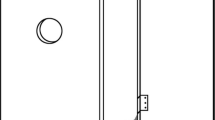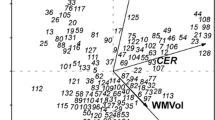Abstract
Old hollow trees have declined in Europe and many saproxylic (i.e. wood-dwelling) invertebrates living on them are threatened. The aim of this study was to investigate to what extent artificial habitats can be exploited by saproxylic beetles. To mimic the conditions in tree hollows, we constructed wooden boxes filled with different combinations of substrates like oak saw dust, oak leaves, a dead hen (Gallus domesticus), chicken dung, lucerne flour or potatoes and placed them on tree trunks. To investigate the importance of distance from dispersal sources, we placed boxes at different distances (0–1,800 m) from three species-rich sites with high densities of hollow oaks. Over 3 years, 3,423 specimens of 105 saproxylic beetle species were caught in 47 boxes. Among beetles found in hollow oaks that were either tree-hollow species, bird nest species, or wood rot species, 70% were also found in the boxes. A dead hen added to the artificial wood mould gave a higher number of beetle specimens. The number of species associated with tree hollows in oak decreased with distance from sites with hollow oaks. In conclusion, the prospects for using artificial environments for boosting substrate availability, or to fill spatial and temporal gaps therein, for saproxylic beetles are good.





Similar content being viewed by others
References
Birtele D (2003) The succession of saproxylic insects in dead wood: a new research method. In: Mason F, Nardi G, Tisato M (eds) Dead wood: a key to biodiversity. LIFE nature project NAT/IT/99/6245. Montova, Italy, pp 91–93
Bull EL, Williams WG (1981) Creating snags with explosives. USDA forest service research note PNW-393. Pacific northwest forest and range experimental station, Oregon, pp 1–4
Buse J, Schröder B, Assmann T (2007) Modelling habitat and spatial distribution of an endangered longhorn beetle—a case study for saproxylic insect conservation. Biol Conserv 137:372–381
Cavalli R, Donini F (2003) Possible management actions to increase the amount of dead and marcescent wood. In: Mason F, Nardi G, Tisato M (eds) Dead wood: a key to biodiversity. LIFE nature project NAT/IT/99/6245. Montova, Italy, pp 45–48
Dajoz R (2000) Insects and forests. The role and diversity of insects in the forests environment. Intercept Ltd, London
Dodelin B, Ballot P, Stokland JN (2008) The saproxylic database check list of beetles vers. 8/2008. www.saproxylic.org. Cited in Aug 2008
Eliasson P, Nilsson SG (2002) “You should hate young oaks and young noblemen”. The environmental history of oaks in eighteenth- and nineteenth-century Sweden. Environ Hist 7:659–677
Flyger V, Cooper HR (1967) The utilization of nesting boxes by gray squirrels. Proceedings of the 21st annual conference of southeastern association of game fish commissioners, 21, pp 113–117
Gärdenfors U (2005) Rödlistade arter i Sverige 2005—The 2005 Redlist of Swedish species. Swedish Species Information Centre, SLU, Uppsala
Gibbons P, Lindenmayer D (1996) Issues associated with retention of hollow-bearing trees within eucalypt forests managed for wood production. For Ecol Manage 83:245–279
Gibbons P, Lindenmayer D (2002) Tree hollows and wildlife conservation in Australia. CSIRO Publishing, Collingwood, Australia
Green T (1995) Creating decaying trees. Br Wildl 6(5):310–311
Hannah L, Carr JL, Lankerani A (1995) Human disturbance and natural habitat: a biome level analysis of a global data set. Biodivers Conserv 4:128–155
Harding PT, Rose F (1986) Pasture-woodlands in lowland Britain. A review of the importance for wildlife conservation. Natural Environment Research Council, Institute of Terrestrial Ecology, Huntington
Hilty JA, Lidicker WZ, Merenlender AM, Dobson AP (2006) Corridor ecology: the science and practice of linking landscapes for biodiversity conservation. Island Press, Washington
Kaila L, Martikainen P, Punttila P, Yakovlev E (1994) Saproxylic beetles (Coleoptera) on dead birch trunks decayed by different polypore species. Ann Zool Fenn 31:97–107
Kellner-Pillault S (1974) Étude écologique du peuplement entomologique des terraux d’arbres creux (chataigners et saules). B Ecol 5:123–156
Kirby KJ, Watkins C (1998) The ecological history of European forests. CAP International, Oxon
Kirby KJ, Thomas RC, Key RS, McLean IFG (1995) Pasture-woodland and its conservation in Britain. Biol J Linn Soc 56(Suppl):135–153
Klein HG (1955) Wood duck production and use of nest boxes on some small mashes in New York. New York Fish and Game J 2(1):68–83
Lindhe A, Lindelöw Å, Åsenblad N (2005) Saproxylic beetles in standing dead wood density in relation to substrate sun-exposure and diameter. Biodivers Conserv 14:3033–3053
Lundberg S (1995) Catalagus Coleopterorum Sueciae. Naturhistoriska Riksmuseet. Stockholm, Sweden
Martin O (1989) Click beetles (Coleoptera, Elateridae) from old deciduous forests in Denmark. Ent Meddel 57:1–107
McComb WC, Noble RE (1982) Invertebrate use of natural tree cavities and vertebrate nest boxes. Am Midl Nat 107:163–171
McLean IFG, Speight MCD (1993) Saproxylic invertebrates—the European context. In: Kirby KJ, Drake CM (eds) Dead wood matters: the ecology and conservation of saproxylic invertebrates in Britain. English Nature, Peterborough, pp 31–32
Nilsson SG (1997) Forests in the temperate-boreal transition: natural and man-made features. Ecol Bull 46:61–71
Nilsson SG, Baranowski R (1997) Habitat predictability and the occurrence of wood beetles in old growth beech forests. Ecography 20:491–498
Noss RF (1993) Wildlife corridors. In: Smith DS, Hellmund PC (eds) Ecology of greenways. University of Minnesota Press, Minneapolis, pp 43–68. ISBN 0-8166-2157-8
Økland B (1996) A comparison of three methods of trapping saproxylic beetles. Eur J Entomol 93:195–209
Ranius T (2002) Influence of stand size and quality of tree hollows on saproxylic beetles in Sweden. Biol Conserv 103:85–91
Ranius T (2006) Measuring the dispersal of saproxylic insects: a key characteristic for their conservation. Popul Ecol 48:177–188
Ranius T (2007) Extinction risks in metapopulations of a beetle inhabiting hollow trees predicted from time series. Ecography 30:716–726
Ranius T, Jansson N (2000) The influence of forest regrowth, original canopy cover and tree size on saproxylic species associated with old oaks. Biol Conserv 95:85–94
Ranius T, Nilsson SG (1997) Habitat of Osmoderma eremita Scop. (Coleoptera: Scarabaeidae), a beetle living in hollow trees. J Insect Conserv 1:193–203
Ranius T, Wilander P (2000) Occurrence of Larca lata HJ Hansen (Pseudoscorpionida: Garypidae) and Allochernes wideri CL Koch (Pseudoscorpionida: Chernetidae) in tree hollows in relation to habitat quality and density. J Insect Conserv 4:23–31
Ranius T, Niklasson M, Berg N (2009) Development of tree hollows in pedunculate oak (Quercus robur). For Ecol Manage 257:303–310
Statsoft Inc (2004) STATISTICA (data analysis software system), version 7
ter Braak CJF, Smilauer P (2002) Canoco reference manual and user’s guide to Canoco for windows: software for Canonical Community Ordination (version 4). Microcomputer Power, Ithaca
Toole ER (1965) Inoculation of bottom-land red oaks with Poria ambigua, Polyporus fissilis and Polyporus hispidus. Plant Disease Reporter 49:81–83
Whitehead PF (1998) Compost bins and other artificially created biotopes as biological conservation agents for xylophilus Coleoptera. Entomol Gaze 49:257–260
Yee M, Yuan Z-Q, Mohammed C (2001) Not just waste wood: decaying logs as key habitats in Tasmania’s wet sclerophyll Eucalyptus obliqua production forests: the ecology of large and small logs compared. Tasforests 13:119–128
Acknowledgments
We are grateful to the land owners at Sturefors, Bjärka Säby and Brokind for letting us use their oaks in this study and Bobergs Valltork for the lucern flour. We would like to thank Kenneth Claesson and Annika Forslund with family for helping us with the field work and entomologists for help with identification of some of the species: Stig Lundberg, Rickard Andersson, Arne Ekström, Stanislav Snäll and Hans Bartsch. We would also like to thank Ted Green for interesting and fruitful discussions about creating artificial hollows and wood mould. Financial support for this project came from Stiftelsen Eklandskapet i Linköpings kommun, Stiftelsen Oscar och Lili Lamms minne, Larsénska Fonden and The Swedish Research Council for Environment, Agricultural Sciences and Spatial Planning (Formas, to Thomas Ranius’ project “Metapopulation dynamics of invertebrates associated with dead wood types differing in patch dynamics”).
Author information
Authors and Affiliations
Corresponding author
Rights and permissions
About this article
Cite this article
Jansson, N., Ranius, T., Larsson, A. et al. Boxes mimicking tree hollows can help conservation of saproxylic beetles. Biodivers Conserv 18, 3891–3908 (2009). https://doi.org/10.1007/s10531-009-9687-2
Received:
Accepted:
Published:
Issue Date:
DOI: https://doi.org/10.1007/s10531-009-9687-2




